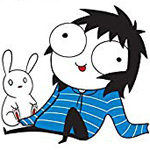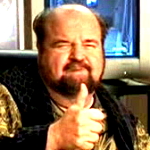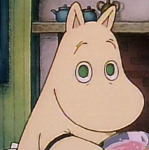You are not logged in.
#121 17.10.2019 14:24
- ydis
- vegan princess

- Registered: 07.03.2006
- Posts: 22,060
Re: Magma
Pitää kuunnella uusi levy jossain vaiheessa mutta mielenkiinto laski huomattavasti kun kuulin että vander ei soita rumpuja tuolla, itselleni erittäin suuri osa magman hyvyyttä juuri tuo rumpalointi
Offline
#122 17.10.2019 15:36
- marjapoimuri
- veli käni

- Registered: 03.09.2019
- Posts: 9,999
Re: Magma
MD: How did you come to record Zess with Magma?
Morgan: Its still a little bit of a mystery. I met Christian Vander, the drummer and founder of Magma, in 2000, when they had a thirty-year anniversary. I met Christian after the gig and we connected. Then I found an excuse to go to Paris to see them again. I emailed Modern Drummer and offered to do a story on Christian, and the editor at the time, Bill Miller, accepted my offer. Christian has some incredible stories about when he grew up; he met Elvin Jones when he was ten years old. Christian is not impossible to interview, but I dont think he grants many. So this was a good excuse for me to see Christian again, and when Magma scheduled another gig in Paris, I booked a meeting with him.
MD: What happened more recently with Magma?
Morgan: Magma came to Sweden in 2015, and Mats and I opened for them. This year is the bands fifty-year anniversary, and theyre planning some rereleases. They also wanted to rerecord a classic Magma song with Christian singing, so they asked me if I wanted to track the song Zess with them, saying Christian can sing and I can drum, and record it live in the studio. The song is twenty-five minutes long.
MD: How would you describe the music?
Morgan: It has chords repeating forever with a few breaks. And a lot of spoken word by Christian in the beginning; the words are like the building blocks. At the recording session was Magmas bass player, Philippe Bussonnet, plus Christian Vander, a piano player, and then Stella Vander, the vocalist. There were no charts, but they sent sound files in advance. We performed the track live in the studio with Christian singing with us.
MD: How did you approach the drumming?
Morgan: It was quite hard because the song is fast and very quiet. The pattern is not far away from the classic Billy Cobham song Quadrant 4. If you remove a bit of the bass drum, the action is based more in the hands and at a very low volume. Its kind of a very fast shuffle. Its not the tempo thats hard, but when you play the same thing for twenty minutes it can be difficult. You dont want to loop anything, and you dont want to lose the beat. And with it being twenty minutes long, you dont want to mess things up two minutes before the end and have to redo everything. So it was a big challenge.
MD: Did Christian have any comments or ideas about the drumming?
Morgan: I felt he trusted me. Also, I sent the band some simple recordings from my studio with ideas for parts. I needed to get that confirmed before going to the studio. We did two or three versions.
En todellakaan haluis soittaa tota rummuilla. Mutta en olekaan ammattilainen.
Tuanoi saatana.
Offline
#123 18.10.2019 01:22
- marjapoimuri
- veli käni

- Registered: 03.09.2019
- Posts: 9,999
Re: Magma
Magma on musiikin Star Wars.
Tuanoi saatana.
Offline
#124 25.10.2019 19:16
- marjapoimuri
- veli käni

- Registered: 03.09.2019
- Posts: 9,999
Re: Magma
Vanderin intohimoinen laulusekoilu ja tapa näppäillä mikrofonia niinku se olis joku trumpetti 
Tuanoi saatana.
Offline
#125 09.11.2019 01:41
- marjapoimuri
- veli käni

- Registered: 03.09.2019
- Posts: 9,999
Re: Magma
Miks magma on parempi ku kaikki progebändit?
Tuanoi saatana.
Offline
#126 13.11.2019 19:22
- marjapoimuri
- veli käni

- Registered: 03.09.2019
- Posts: 9,999
Re: Magma
Live in Tokyo. Vuosi 2005, ekalla levyllä K.A. Toka levy spessuhomma, missä hamtaahk, wurdah, mdk lyhennettyinä MUTTA ei rumpuja eikä muitakaan, lähinnä piano+helistimet+laulu. Toimii.
Tuanoi saatana.
Offline
#127 03.12.2019 12:52
- hezma
- Vanhempi Käynnissäpitäjä

- From: Helesinki
- Registered: 13.11.2008
- Posts: 17,648
Re: Magma
Onkos Zao miten tuttu?
A French fusion super-group, formed in 1971 by two early members of Magma: François "Faton" Cahen and Jeff "Yochk'o" Seffer, and featuring many other talents of the 1970's prog and fusion fields. Zao took the Magma "Zeuhl" brand of fusion and jazzed it up a bit, adding folk elements of Seffer's cultural heritage, and lots of other unique touches. After Seffer left, the band became more jazz-rock. They have reformed at least twice since disbanding in the late 1970's.
Mullon kaks levyä: Osiris (toka, 1974) ja Kawana (neljäs, 1976). Semmosta zeuhl-laulua tais olla näissä aika vähän, mutta kuunnellaas pitkästä aikaa ku emmuista.
Offline
#128 03.12.2019 14:08
- hezma
- Vanhempi Käynnissäpitäjä

- From: Helesinki
- Registered: 13.11.2008
- Posts: 17,648
Re: Magma
No Osiriksella sitä laulua on kyllä enemmänkin ja se näistä on magmaisempi, mut hyviä levyi molemmat.
Offline
#129 03.12.2019 14:22
- marjapoimuri
- veli käni

- Registered: 03.09.2019
- Posts: 9,999
Re: Magma
Ekalla Z=7L on zeuhl laulua ja siksi minulla onkin vain se.
Tuanoi saatana.
Offline
#130 18.01.2020 19:39
- marjapoimuri
- veli käni

- Registered: 03.09.2019
- Posts: 9,999
Re: Magma
Pitäsköhän matkustaa alkukevään ranskan kiertueelle? Jos sais nauttia vähän paremman keikan ku se sidewaysin tapaus.
Tuanoi saatana.
Offline
#131 22.02.2020 21:39
- marjapoimuri
- veli käni

- Registered: 03.09.2019
- Posts: 9,999
Offline
#132 11.05.2020 14:20
- marjapoimuri
- veli käni

- Registered: 03.09.2019
- Posts: 9,999
Re: Magma
Kappalevalinnasta olisin kyllä voinut vähän nillittää ![]()
Tuanoi saatana.
Offline
#133 09.09.2020 17:21
- marjapoimuri
- veli käni

- Registered: 03.09.2019
- Posts: 9,999
Re: Magma
Bourges '79 on tehty paranneltu ja remasteroitu versio. Tämä minulta puuttuukin.
Tuanoi saatana.
Offline
#134 18.09.2020 20:55
- marjapoimuri
- veli käni

- Registered: 03.09.2019
- Posts: 9,999
Re: Magma


Tuanoi saatana.
Offline
#135 18.09.2020 21:20
- marjapoimuri
- veli käni

- Registered: 03.09.2019
- Posts: 9,999
Re: Magma
Onhan se muuten aika hyvä että noi laulajat muistaa noi sanat ilman papereita.
Tuanoi saatana.
Offline
#136 18.09.2020 21:23
- marjapoimuri
- veli käni

- Registered: 03.09.2019
- Posts: 9,999
Re: Magma
Huomasin tänään äxässä kun joku melko nuoren näköinen nainen osti magman vinyylin 
Tuanoi saatana.
Offline
#137 13.10.2020 20:02
- marjapoimuri
- veli käni

- Registered: 03.09.2019
- Posts: 9,999
Re: Magma
Bourges 1979 eka cd kuunneltu. Tämä on siis uusintapainos vuoden 2008 julkasusta, missä paranneltu ääntä. Oikeen hyvä setti. Retrovision  seven minutes
seven minutes  harvemmin livenä kuultu urgon gorgo
harvemmin livenä kuultu urgon gorgo  ja korusz xxvi joka jazz/pitkä rumpusoolo biisi. Tokalla ceedeellä mm. mdk
ja korusz xxvi joka jazz/pitkä rumpusoolo biisi. Tokalla ceedeellä mm. mdk 
En ole alkuperästä julkasua kai kuullut, mutta tässä ainakin hyvä bootleg laatu.
Tuanoi saatana.
Offline
#138 15.10.2020 19:53
- marjapoimuri
- veli käni

- Registered: 03.09.2019
- Posts: 9,999
Re: Magma
Pitää kuunnella uusi levy jossain vaiheessa mutta mielenkiinto laski huomattavasti kun kuulin että vander ei soita rumpuja tuolla, itselleni erittäin suuri osa magman hyvyyttä juuri tuo rumpalointi
Tilanne?
Tuanoi saatana.
Offline
#139 16.10.2020 11:25
- ydis
- vegan princess

- Registered: 07.03.2006
- Posts: 22,060
Re: Magma
ydis wrote:Pitää kuunnella uusi levy jossain vaiheessa mutta mielenkiinto laski huomattavasti kun kuulin että vander ei soita rumpuja tuolla, itselleni erittäin suuri osa magman hyvyyttä juuri tuo rumpalointi
Tilanne?
Kuuntelin sen silloin joskus kyllä. Ei jäänyt hirveästi mieleen, tais olla ihan ok, vähän tylsä
Offline
#140 07.05.2021 18:27
- muumipoimuri
- Member

- Registered: 01.12.2020
- Posts: 14,712
Re: Magma
Jonku tyypin näkemyksiä:
Chronologically, the earliest tale in the Kobaïan anthology is that of a man named Köhntarkösz. Köhntarkösz is an Earthling. We assume that this takes place sometime in the near (or maybe distant) future. One day, by whatever means, Köhntarkösz stumbled upon a long forgot, ancient tomb, belonging to a former Egyptian Emperor. This makes us think that Köhntarkösz was an archeologist, historian, researcher, or perhaps just lucky explorer. At any rate, the tomb belongs to Ëmëhntëht-Rê, who, in his life, sought nothing more than to discover the secrets of eternal life. Ëmëhntëht-Rê came close to accomplishing his goal, but before he completed his task, he was murdered. We’re unsure whether the murder was related to his work: whether an underground organization wanted the secrets of endless life to go unearthed, or if the Emperor’s reign was won by revolt, or if the Emperor just owed somebody a lot of money. Who knows, maybe Ëmëhntëht-Rê fell on the knife.
While inside Ëmëhntëht-Rê’s tomb, Köhntarkösz is met by a startling and vivid vision of the bygone Emperor. It is in this fashion that Ëmëhntëht-Rê’s wealth of knowledge and wisdom, regarding life, death, man, God, time, existence, and eternal life is passed to the humble Köhntarkösz, who now, revealed the truth, sees how evil mankind is, and how imperfect Earth is...and sees a solution. However, I believe that in this moment a prophecy was also made: and it is articulated in the song Ork Alarm. The prophecy is essentially that if ever the secrets and wisdom of Ëmëhntëht-Rê would be harnessed to craft the ideal society; if ever human life was perfected; if indeed the evil of man was surpassed; the People of Ork would come and end it. The People of Ork would destroy all progress. Perhaps the prophecy isn’t an ‘if’ situation: maybe even Köhntarkösz seeing the vision was enough to spit the People or Ork out of their waiting. Maybe from that moment the People of Ork have been on their way (which would mean either they live a couple hundred galaxies over, or their ship runs on diesel.) What is for certain is that the People of Ork will play a large role in the distant future of mankind.
The booklet of the CD issue of Köhntarkösz reads: “The people of ORK are marching upon us. The people are made of indescribable matter which to the machines is what the machines are to man. The alarm is sounded... ORK ALARM! The people of ZEUHL WORTZ are preparing for battle...” It sounds as though the People of Ork will, in the future, attack Kobaïa. Maybe they will attack Earth, and the Kobaïans will save Earth from them. I personally think it’s the former. What is important here is that a prophecy is made of the invasion of an advanced, alien race, organic yet different than man and his animal allies. I presume that the two bubbling fat fellows Ourgon and Gorgo on the cover of Attahk are People of Ork.
That concludes what happens in Köhntarkösz, by my guess. Next in the Köhntarkösz series is K.A, or Köhntarkösz Anteria. What is most frustrating about this album is not only the fact that is the only currently released Magma album that I know virtually nothing about for certain, but also the fact that it is the only Magma album I have the complete lyrics for. God, I wish I spoke Kobaïan. But alas, I don’t, and therefore I’ll do my best guesswork at what comes next. (I can almost guarantee this section is false, but consider it.)
Judging by the cover, (which strongly resembles a headstone), and the word “Anteria” which strongly resembled the English "Interred", and the French “En Terre” which is literally “In Earth”, i.e., buried, i.e., Wurdah Köhntarkösz. That’s right, I think Köhntarkösz dies in the sequel. This could happen by a number of means: maybe Mr. K was hunted down the by the same underground society that killed of Ëmëhntëht-Rê. Maybe Mr. K just grew old before his plans were executed, and passed his knowledge on to another, in a similar manner Ëmëhntëht-Rê did. (Or, maybe Köhntarkösz was a bit more traditional and just passed his knowledge vocally to his pupils). I think, personally, that what happened to Köhntarkösz was very much like what happened to the Kobaïans in the future when they tried to share their wisdom, but the results weren’t those Nebëhr Gudahtt received even further in the future.
I think Köhntarkösz preached his wisdom: his visions of the fruitless future of mankind, of the evilness of their ways, of the impurity of our means, and our dire need to mend our ways. He was shunned and rejected by the general public, and Earth’s authorities tried to silence him. When they were unsuccessful, they had him killed. The booklet of K.A reads, “La jeunesse tourmentée de Köhntarkösz en quête de sa destinée. Cependant la providence guide déjà ses pas…” My French isn’t brilliant, but this essential translates to “The tormented youth of Köhntarkösz in quest of,” or “in searh of” or “in pursuit of his destiny. Nevertheless, providence already guides his feet…” This quote leads me to believe that Köhntarkösz is devoting his life to his plans for the perfect Earth, the ideal society, and to bringing his ideals to life.
(Here is a large gap in my vision of the plot. The soon to be released – if it’s not delayed by the recent departure of three band members - “Ëmëhntëht-Rê” is placed here next in this trilogy. However, I have no idea at all what it could be about. Maybe I compressed too much into K.A. Maybe K.A is merely about Köhntarkösz sharing wisdom and recruiting followers, but it isn’t until Ëmëhntëht-Rê that he dies. Or, maybe (most likely) I missed the mark completely. Any insight would be great.)
After his death, Köhntarkösz’ few followers secretly continued his goals, outside the watch of the government, and finally decided Ïtah suah Wurdah: Earth is dead (alright, I know a little Kobaïan.) They abandon it: it is beyond saving. The few enlightened ones must find a new world; begin anew if they are ever to bring about this ideal society. Now we begin the tale of their debut double-album, Kobaïa, whose plot is a very simple one. Disc One: these enlightened ones travel the universe on their advanced spacecraft, in search of the perfect planet. They find Kobaïa, and it all advances from there. The build their society from scratch, and in a matter of years, Kobaïa is a blooming utopia. Disc Two: Many years in the future, a totaled spacecraft is found hovering in orbit of the planet, unable to penetrate the atmosphere. The Kobaïans investigate, and find a crew of lost wayward Earthlings. The Earthlings see Kobaïa, and the startling progress they’ve made. The Earthlings plea for their aid, and tell that Earth is in even worse shape now. They beg the Kobaïans to return to Earth, tell of the great progress they’ve made politically, environmentally, technologically, spiritually, socially, and scientifically. They ask the Kobaïans to preach their ways to the deluded population of Earth.
They oblige, and a small crew of knowledgeable Kobaïans returns to Earth. Thus concludes their debut, and begins 1001º Centigrades. Returning to the ancient home of their forefathers, the Kobaïans begin to preach their methods, and show Earth the depths they’d fallen to. Some humans were truly touched and believed in the Kobaïan message. But, the majority rejected these beliefs, and the authority of Earth arrested and imprisoned the Kobaïans. The remaining Kobaïans back home warn Earth’s government that if their imprisoned brethren were not released and sent back safely, they would be forced to unleash their ‘ultimate weapon’ on them. The ultimate weapon could be a building-bashing monster, a plague of flesh-eating insects, the Death Star (or a similar laser-beam emitting planet-destroyer), or pretty much anything else you can imagine. (Or, maybe the weapon is something much simpler - something we wouldn't normally consider a weapon.) At any rate, the imprisoned Kobaïans are released on a single term: no Kobaïan may ever step foot on Earth’s soil again. And with that, the Kobaïans leave Earth for eternity, and never again show their faces there. This concludes 1001º Centigrades.
Moving now to another section of the saga: the most popular trilogy. Now, between the final departure of the Kobaïans and the redemption of all Earth, many years later, is a time referred to as Theusz Hamtaahk, which translates to Time of Hatred. Theusz Hamtaahk was never recorded in studio, but was performed frequently live. Together with its sequel, Wurdah Ïtah (Dead Earth, in case you weren’t paying attention earlier) these two albums depict the span of time where man commits his most dastardly crimes, performs his greatest evils, conducts behavior most devoid of moral, spiritual guidance, or of fear of their impending doom. Throughout this Theusz Hamtaahk on Earth, the few who heeded the Kobaïans’ warning way back when passed the knowledge they learned down through the generations. This knowledge being shared through the years was the sole banner of hope for all of Earth. And finally, Nebëhr Gudahtt came along, and was the first who had courage enough to act on his beliefs. This is the situation we find ourselves in at the beginning of .M.D.K., Magma’s most popular album, and arguably, the first real Zeuhl album.
There is a reason Mëkanïk Destruktïw Kommandöh is so grandiose and epic. It is because of the powerful moral statement at its core. Nebëhr Gudahtt won more followers than Köhntarkösz, the original Kobaïans, and the Kobaïans who came to earth later, all combined. In fact, Nebëhr Gudahtt essentially won all of earth to the ways of Kobaïa, in the end. What occurred was this - and I’m just going to go ahead and directly quote Peter Thelen here, because he worded it so perfectly here. “His message to the people of Earth is that their only salvation from an ultimate and certain doom is through self purification and communication with the divine spirit of the supreme being, the Kreuhn Kohrman.” Gudahtt then began his march to spiritual purity, and to the redemption and salvation of all humanity. Earthlings initially reject his invitation and his insane claims, and they begin to march against him. But then they slowly begin to question their actions, and then their purpose and very existence, and one at a time converted to the ways of Kobaïa, until every single Earthling was marching together, towards spiritual enlightenment.
Thus ends .M.D.K., and thus ends the Theusz Hamtaahk cycle. Following the Theusz Hamtaahk trilogy, very little is known. Attahk and Üdü Wüdü are the only remaining albums Magma released. (No, I am not overlooking any album.) I think that, in very short, these two albums narrate the Kobaïan war with the People of Ork. I am likely very far off here, and I’ve heard that certain pieces scattered across them (and certain live albums) are actually linked to the Ëmëhntëht-Rê tale, so I might even be wrong in terms of chronology. But one thing I’m rather certain of is that Ourgon and Gorgo are People of Ork, and they mean the Kobaïans harm.
I have a handful of ideas what De Futura could be about, but it’s clear it has something to do with the passage of time, and similarly the future of war. (It was originally named De Futura Hiroshima, which leads us to believe it’s about WWIII and atomic war.)
In the end, I’m not really sure about anything. These are merely my guesses, and if they are all concluded to be entirely false, then consider it fan-fiction. Experts: enlighten me on my faults.

Offline
#141 20.07.2021 17:09
- muumipoimuri
- Member

- Registered: 01.12.2020
- Posts: 14,712
Offline
#142 15.08.2021 19:40
- muumipoimuri
- Member

- Registered: 01.12.2020
- Posts: 14,712
Re: Magma
Tässä hyvälaatuinen konserttitallenne vuodelta 96.

Offline
#143 03.09.2021 12:28
- muumipoimuri
- Member

- Registered: 01.12.2020
- Posts: 14,712
Re: Magma
UUNITUORE LIVELEVY PUTOSI POSTILUUKUSTA ÖÖÖÖÖÖÖÖÖÖÖÖÖÖÖÖÖJJ!!!

Offline
#144 03.09.2021 19:51
- muumipoimuri
- Member

- Registered: 01.12.2020
- Posts: 14,712
Re: Magma
Vander (his Kobaïan name is Zëbëhn Straïn dë Ğeuštaah) said in an interview that he invented Kobaïan for Magma because "French just wasn't expressive enough. Either for the story or for the sound of the music". He said that the language developed in parallel with the music, that sounds appeared as he was composing on a piano. Vander based Kobaïan in part on elements of Slavic and Germanic languages and in part on the scat-yodeling vocal style of American avant garde jazz singer Leon Thomas.

Offline
#145 03.09.2021 20:16
- muumipoimuri
- Member

- Registered: 01.12.2020
- Posts: 14,712
Re: Magma
UUNITUORE LIVELEVY PUTOSI POSTILUUKUSTA ÖÖÖÖÖÖÖÖÖÖÖÖÖÖÖÖÖJJ!!!
Vitu kova eka cd. Tuusamtaak anthology eli koko trilogia tiivistettynä 55 minuuttiin.

Offline
#146 03.09.2021 20:55
- muumipoimuri
- Member

- Registered: 01.12.2020
- Posts: 14,712
Re: Magma
Dondaï > Donda

Offline
#147 08.12.2021 20:14
- muumipoimuri
- Member

- Registered: 01.12.2020
- Posts: 14,712
Offline
#148 07.03.2022 17:57
- muumipoimuri
- Member

- Registered: 01.12.2020
- Posts: 14,712
Offline
#149 25.03.2022 21:27
- muumipoimuri
- Member

- Registered: 01.12.2020
- Posts: 14,712
Re: Magma
Pitäsköhän ostaa nää hienot uusintapainokset ja myydä orkkikset pois?

Offline
#150 25.03.2022 21:29
- muumipoimuri
- Member

- Registered: 01.12.2020
- Posts: 14,712
Re: Magma
Kai me ollaan kaikki yhtä mieltä siitä että MDK paras teos?
Vaikka kyllä ne muutki yltää about 5/5 kategorioon.

Offline
